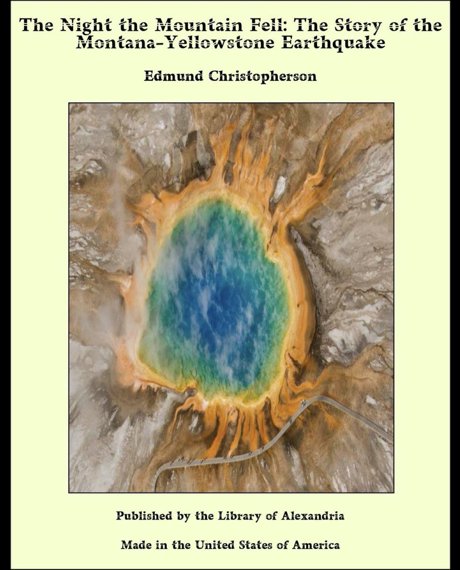The Night the Mountain Fell: The Story of the Montana-Yellowstone Earthquake
The Night the Mountain Fell: The Story of the Montana-Yellowstone Earthquake
€ 4,99
August is a busy month in the exciting mountain vacation area that centers in West Yellowstone, Montana, and includes Yellowstone National Park, the restored ghost town of Virginia City, the nationally famous trout fishing reach of Madison Canyon that runs through the Gallatin National Forest, plus dude ranches and lakes in the parts of Montana, Wyoming and Idaho where the three states come together. Geologically, it’s a new area, where enormous forces are still thrusting up mountains, where volcanic craters still exist, and where the heat of the earth still spouts its imprisoned fury through the geysers that have made Yellowstone Park’s Firehole Basin famous. At 11:37 P. M. on Monday, August 17, 1959, one of the severest earthquakes recorded on the North American continent shook this area. It sent gigantic tidal waves surging down the 7-mile length of Hebgen Lake, throwing an enormous quantity of water over the top of Hebgen Dam, the way you can slosh water out of a dishpan, still keeping it upright. This water—described as a wall 20 ft. high—swept down the narrow Madison Canyon, full of campers and vacationers who were staying in dude ranches and at three Forest Service campgrounds along the seven-mile stretch from the dam to the point where the canyon opened up into rolling wheat and grazing land. Just about the time this surge of water reached the mouth of the canyon, half of a 7,600-ft.-high mountain came crashing down into the valley and cascaded, like water, up the opposite canyon wall, hurtling house-size quartzite and dolomite boulders onto the lower portion of Rock Creek Campground. This slide dammed the river and forced the surging water—carrying trees, mud, and debris, back into the campground. The campers who’d escaped being crushed under part of the 44 million cubic yards (80 million tons) of rock found themselves picked up and thrown against trees, cars, trailers, the side of the canyon, etc. Heavy, 4,000 pound cars were tossed 40 ft. and smashed against trees by the force of the ricocheting water and the near-hurricane velocity wind created by the mountainfall. Other cars were scrunched to suitcase thickness and thrown out from under the slide. And the water stayed—held by the earthquake-caused natural dam. It began to flood the lower end of the canyon. At the upper end, big sections of the road that would take the 300 people trapped in the canyon to safety crumpled and fell into Hebgen Lake, cutting them off from the world outside.
August is a busy month in the exciting mountain vacation area that centers in West Yellowstone, Montana, and includes Yellowstone National Park, the restored ghost town of Virginia City, the nationally famous trout fishing reach of Madison Canyon that runs through the Gallatin National Forest, plus dude ranches and lakes in the parts of Montana, Wyoming and Idaho where the three states come together. Geologically, it’s a new area, where enormous forces are still thrusting up mountains, where volcanic craters still exist, and where the heat of the earth still spouts its imprisoned fury through the geysers that have made Yellowstone Park’s Firehole Basin famous. At 11:37 P. M. on Monday, August 17, 1959, one of the severest earthquakes recorded on the North American continent shook this area. It sent gigantic tidal waves surging down the 7-mile length of Hebgen Lake, throwing an enormous quantity of water over the top of Hebgen Dam, the way you can slosh water out of a dishpan, still keeping it upright. This water—described as a wall 20 ft. high—swept down the narrow Madison Canyon, full of campers and vacationers who were staying in dude ranches and at three Forest Service campgrounds along the seven-mile stretch from the dam to the point where the canyon opened up into rolling wheat and grazing land. Just about the time this surge of water reached the mouth of the canyon, half of a 7,600-ft.-high mountain came crashing down into the valley and cascaded, like water, up the opposite canyon wall, hurtling house-size quartzite and dolomite boulders onto the lower portion of Rock Creek Campground. This slide dammed the river and forced the surging water—carrying trees, mud, and debris, back into the campground. The campers who’d escaped being crushed under part of the 44 million cubic yards (80 million tons) of rock found themselves picked up and thrown against trees, cars, trailers, the side of the canyon, etc. Heavy, 4,000 pound cars were tossed 40 ft. and smashed against trees by the force of the ricocheting water and the near-hurricane velocity wind created by the mountainfall. Other cars were scrunched to suitcase thickness and thrown out from under the slide. And the water stayed—held by the earthquake-caused natural dam. It began to flood the lower end of the canyon. At the upper end, big sections of the road that would take the 300 people trapped in the canyon to safety crumpled and fell into Hebgen Lake, cutting them off from the world outside.
| Prijs | Verzendkosten | Totaal | |
|---|---|---|---|
€ 4,99 | € 0,00 | € 4,99 |
Alternatieve producten
© 2016 - 2024 aanbiedingchecker


/backgroundcolor(255,255,255)/jpg(90)/fetch/https://media.s-bol.com/N7NkV3wK6NQm/66nM5j9/1200x1200.jpg)